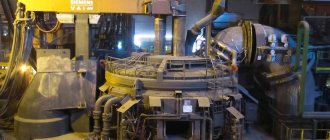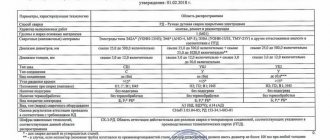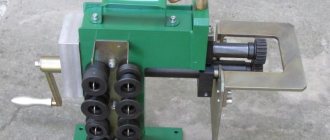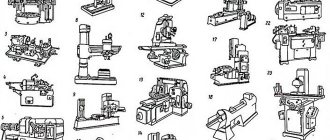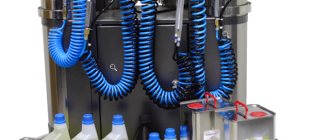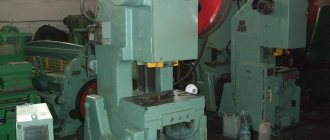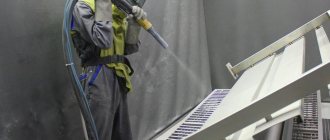Thermal equipment is actively used by factories and thermal workshops to carry out various processes involving heating. As a rule, in installations of this type, metals are heated to their melting point in order to change their properties.
Navigation:
- Heat treatment equipment
- Vacuum ovens
- Industrial ovens
- Hydrogen ovens
- Thermal industrial equipment
- Modernization of thermal equipment
Heat treatment equipment
Heat treatment equipment can have various capabilities that facilitate specific processes. This applies to the maximum temperature created in it, the amount of material processed simultaneously, and the type of processing performed.
Equipment for heat treatment at various enterprises is presented:
- shaft furnaces;
- chamber furnaces;
- ovens with a retractable hearth;
- vacuum furnaces;
- melting presses;
Shaft furnaces have high productivity and can process materials of large dimensions. With their help, it is possible to carry out heat treatment for the operation of hardening, annealing, tempering, and normalizing non-ferrous metals. The application is optimal for enterprises that do not focus on the accuracy of operations.
Today, various enterprises produce shaft furnaces that have electric and gas heating. Installations of this type can be used in endogas, nitrogen, air, vacuum and hydrogen environments. Their main application is the heat treatment of large steel elements. These include steel parts and assemblies, large-sized castings and forgings. In addition, they are normalized and rolled out.
Chamber heat treatment furnaces have smaller dimensions and are therefore used to change the properties of small objects. Installations of this type are popular in various types of production. They can be used either separately or in conjunction with automated systems.
The set of equipment for heat treatment may include:
- heating furnaces;
- hardening tank;
- washing chambers;
- vacation cameras;
Tempering chambers in some installations are combined with a cooling container to avoid temper brittleness. Chambers are often used in which the elements are treated with cold, this helps reduce retained austenite. The automated complex may include a rail transport system for loading and unloading.
Furnaces with a retractable hem are the optimal tool for heat treatment of parts or assemblies that have large dimensions. To carry out loading and unloading, cranes and overhead cranes are used. Among the disadvantages, large heat loss can be eliminated. This is due to their size. They are used to perform austenitization and annealing. Often used to heat metal before the forging procedure. Small manipulators and robots can be used to load items. The workspace can be heated by gas or electricity.
Additional mechanisms for providing heat treatment furnaces
Some types of production produce rolled products. This includes profiles, pipes, welded structures, etc. To give the required shape before or before the part enters the thermal oven, special temperature presses are used to straighten surfaces. There are dynamic impact devices and static units. The first option involves creating the desired geometry using pulsed impacts with the surface of a press for thick-walled or rolled pipes. Static presses make smooth and slow straightening of thin-walled pipes and profiles of various shapes. The editing procedure itself takes little time and includes the geometry control stage, the editing itself and final quality control. When highly critical products are processed on such a device, individual low-temperature tempering is used to relieve metal stress, carried out at a temperature of about 200 degrees.
After the product has undergone heat treatment, it must be tested to ensure the required quality. For these purposes, a stationary hardness tester is used, which provides operational control directly at the production site. If the object being processed has large dimensions that do not allow readings to be taken with a standard device, it is possible to use portable hardness testers, which differ in the direct method of measurement and the indirect option of reading mechanical properties. Some industries often use coercimeters, the main purpose of which is to control the chemical-thermal hardness, depth of the formed layer and other parameters on sample parts. In parallel with this device, portable microscopes with a dimensional grid printed on the lens can be used.
Vacuum ovens
Vacuum furnaces are the optimal means to produce high-quality tools, high-speed steels, titanium alloys, copper, refractory metals and structural steels. Vacuum furnaces carry out all processes with high technological precision parameters. The temperature in them cannot deviate by more than 5 degrees. They are used as components of heat treatment lines.
Vacuum furnaces can use nitrogen, helium, or air. Moreover, their operation does not require the use of water quenching tanks. This makes it difficult to harden low-carbon and low-alloy steels in them. To make the inner surface of a vacuum furnace, molybdenum sheets are used, heating elements are graphite, ceramics, and powder materials.
Installations that have high power are capable of creating a pressure in a vacuum furnace of 0.00005 mbar. The maximum ambient pressure level will be 20 mbar and the temperature will be 1350 degrees. Water is used as a coolant.
Vacuum chambers are equipped with various vacuum pumps, receivers with a gas cooling medium and installations that provide reverse water cooling. The degree of automation of this heat treatment equipment can vary between 0.7-0.9.
Vacuum furnaces are expensive because they require much more money to develop and manufacture. However, they have one drawback, which is due to the fact that the surface of the alloys is dealloyed if high temperatures are used in them.
Vacuum Heat Treatment Equipment
Vacuum furnaces are a type of heat treatment equipment. They are widely used for sintering materials, soldering, and melting metals. A feature of vacuum furnaces is high technological accuracy. The following can be used as quenching media for thermal furnaces :
- Oil.
- Nitrogen.
- Air.
- Helium.
For hardening alloys, water tanks are never used. They complicate the processing of lightly alloyed and low-carbon materials. The inside of the vacuum chambers is made of sheet molybdenum, and the heating elements are made of ceramics and graphite.
Maximum threshold values for vacuum thermal equipment:
- Internal vacuum – 0.0005 mbar.
- Cooling pressure – 20 bar.
- Temperature - 1300ºС.
These parameters are sufficient to carry out high-quality processing of almost all known metals. However, most of them require careful preparation: firing, drying, degreasing, washing. The disadvantages include the high cost of the design, but only vacuum equipment can clean metals from excess gases and improve the quality of the alloy.
Industrial ovens
Numerous design options for industrial furnaces can be classified according to the principle of their operation or the method of releasing thermal energy. Based on this criterion, all industrial furnaces can be divided into fuel- and electric-type installations.
Fuel furnaces use chemical energy that is released during fuel combustion to carry out heat treatment. This occurs due to the fuel-burning elements of the installations. They have almost identical designs in different types of ovens. In the mechanical engineering industry, heat exchanger furnaces are most often used. In them, the heat that is released during fuel combustion is transferred to the heated material. As a rule, machine-building enterprises use radiation and conversion of this type.
Electric furnaces create heat using electricity. There are a number of installations in which the transmission method differs significantly. These are induction, electric arc and resistance furnaces. Equipment in which heat is produced by electricity is of the appropriate type.
Electron beam furnaces convert their energy into heat. When an electron flow, which is accelerated in a vacuum space, collides with a body, rapid internal heating and a melting process occur. Most often, installations of this type are used to melt pure refractory metals.
Electric arc heat treatment furnaces are used for melting refractory metals. Their main element is the arc, which has a high temperature due to the supply of electrical energy to it. Often, installations of this type are used in the smelting and melting of steel and cast iron. They are great for working with non-ferrous metals.
Induction furnaces convert electrical energy into electromagnetic energy. In this case, only the object itself is heated in the installation. The presence of a large number of eddy currents causes objects to quickly melt in the chamber. Installations that have a high frequency rate are used for melting various grades of steel, cast iron and other metals.
How to choose thermal equipment
When choosing thermal equipment, you need to consider the following factors:
- Required heating temperature limits for operation.
- Number of simultaneously used channels and adjustable heat treatment modes.
- Dimensions of processed products.
- Dimensions of the equipment itself, the ability to install and connect it in hard-to-reach places.
- Equipment operating conditions.
- Equipment manufacturer.
- Cost of equipment.
On this page you can place an order for thermal equipment by writing to us by email or calling +7 495 504-28-98. In the “Industrial Thermal Equipment” category there are currently 21 items to choose from.
You can also fill out the feedback form by clicking on the “Get a price” button or using our CRM system button in the lower right corner. If you have any questions about products in the “Industrial Thermal Equipment” category, we will be happy to advise you.
Hydrogen ovens
In vacuum hydrogen furnaces, hydrogen is used in the system during heat treatment. Some furnaces of this type operate with dissociated ammonia and operate continuously. They are perfect for enterprises that establish mass production. Melting metals using a hydrogen sintering furnace is the best option. In addition, vacuum furnaces can effectively fire ceramic materials.
Hydrogen furnaces are equipped with automatic and semi-automatic systems that load material into the furnace, as well as automatic systems that push it into the furnace and unload it after the operation is completed. Hydrogen furnaces can be chamber or bell type.
Hydrogen furnaces typically consist of:
- cylindrical chamber or cap;
- anti-explosion device;
- mobile podium or stand;
- a gas system that has a humidifier and a device that provides afterburning of hydrogen;
- cooling systems;
- power supply systems;
- control systems.
Thermal industrial equipment
Thermal industrial equipment is represented by installations with various functions. One of these is the melting press. It is used to straighten rolled products, pipes, profiles and welded structures. They are equipped with elements that control the editing geometry.
Thermal industrial equipment for the melting process can operate in dynamic or shock mode. As a rule, the cycle is short in length.
Automated process thermal equipment is used for mass production of large-sized components. This is, as a rule, automobile, tractor and aggregate production. The production line can include furnaces of various types and carry out a closed or linear cycle.
Areas of application of thermal equipment
Thermal equipment is popular not only in the metallurgical field. These installations are also popular in a related field - mechanical engineering. Using heat treatment equipment, it becomes possible to produce wear-resistant and durable components for vehicles. In addition, heat treatment helps finished parts better resist corrosion.
Heat treatment equipment is often used in the defense industry. It is thanks to heat treatment that it is possible to achieve high strength of weapon and gun barrels. Thermal equipment is often used in the mining and chemical fields. Various tests are carried out using these installations.
